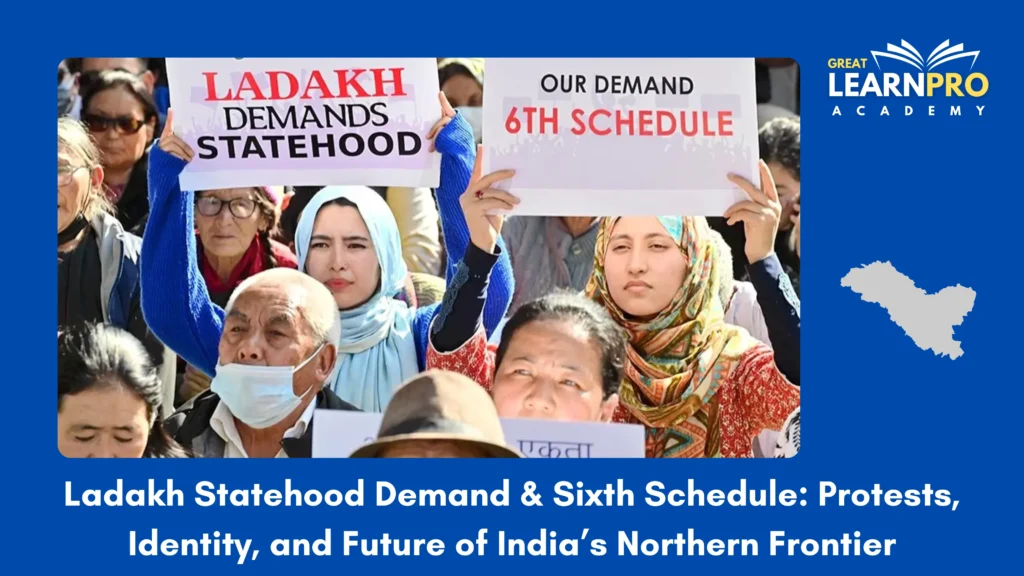Ladakh, India’s northernmost Union Territory, has once again become the focus of national attention, not because of its border tensions with China, but due to the rising local demand for statehood and inclusion in the Sixth Schedule of the Constitution. This movement, driven by concerns of identity, ecology, and political autonomy, has gained momentum in recent months, with protests, hunger strikes, and violent clashes highlighting the seriousness of the issue.

When the Union Government reorganized Jammu and Kashmir in August 2019 and carved out Ladakh as a separate Union Territory, many Ladakhis initially welcomed the decision. They hoped that direct administration from Delhi would bring more focused development to the region. However, the absence of a legislature, coupled with fears of cultural erosion and loss of land rights, soon led to disappointment. Unlike Jammu and Kashmir, Ladakh was not given a legislative assembly, leaving its people with little say in governance. This lack of political representation has now evolved into a strong demand for full-fledged statehood.
At the center of the agitation are two powerful local groups: the Leh Apex Body (LAB) and the Kargil Democratic Alliance (KDA). Despite religious and regional differences—Leh being predominantly Buddhist and Kargil largely Muslim both groups have come together on a common platform. Their united front has made the demand for statehood and constitutional safeguards stronger than ever before. They argue that Ladakh, given its fragile ecology, tribal character, and strategic location, requires special protection that only the Sixth Schedule can provide.
The Sixth Schedule of the Constitution currently applies to certain tribal areas in the North-Eastern states. It provides for Autonomous District Councils with powers over land, forests, agriculture, and cultural practices. For Ladakh, this would mean that local councils could make laws safeguarding land rights, prevent the exploitation of natural resources by outsiders, and preserve the region’s unique cultural identity. With concerns about large-scale migration and commercial exploitation, especially after Ladakh’s increasing exposure to tourism and infrastructure projects, the demand for Sixth Schedule inclusion has become a rallying cry for ordinary Ladakhis.
The recent months have witnessed massive public demonstrations in both Leh and Kargil. Environmental activist Sonam Wangchuk, known for his role in promoting sustainable development in the Himalayas, became the face of the movement when he staged a 35-day hunger strike earlier this year, demanding constitutional safeguards for Ladakh. His protest drew nationwide attention, especially after youth-led demonstrations in Leh turned violent, leading to the death of four people and injuries to dozens more. In Kargil too, sit-ins and hunger strikes have been organized, underscoring that the issue resonates across the Union Territory.
The Government of India, through the Ministry of Home Affairs, has held multiple rounds of talks with representatives from LAB and KDA. A High-Powered Committee (HPC) was constituted to look into the demands, and subcommittees were formed to discuss issues such as job reservations and land rights. While some concessions like enhanced job reservations for locals and recognition of local languages have been made, the core demands of statehood and Sixth Schedule status remain unaddressed. The Centre has been cautious, citing the region’s sensitive geopolitical location and security concerns, given its proximity to China and Pakistan.
For the people of Ladakh, however, these arguments are not sufficient. They fear that without constitutional safeguards, outsiders may acquire land and businesses, marginalizing local communities. They also argue that environmental degradation will accelerate if local decision-making is ignored in favor of centrally driven projects. In a region as ecologically fragile as Ladakh, unchecked development could have irreversible consequences.
The deadlock continues, with Ladakhi leaders warning of an intensified agitation if their demands are not met. They insist that statehood is necessary to give people legislative power and that the Sixth Schedule is essential to safeguard their identity and resources. The protests also highlight a deeper issue the sense of alienation that Ladakhis feel after initially supporting the Union Territory status in 2019.
The path ahead is complex. Granting Ladakh statehood would require a significant political decision from the Centre, while extending the Sixth Schedule beyond the North-East would require constitutional amendments. Both steps involve legal, administrative, and political challenges. Yet, the government cannot ignore the growing frustration and anger on the ground. As recent events in Leh and Kargil have shown, Ladakh’s demands have transformed into a mass movement, and any delay in addressing them could deepen alienation.
In conclusion, the Ladakh issue is no longer limited to border security and military strategy; it has become a question of democracy, identity, and ecological protection. The people of Ladakh are asking for a voice in their governance and for constitutional safeguards that ensure their culture and environment are preserved. Whether the Centre chooses to engage with these demands meaningfully will not only shape Ladakh’s future but also test India’s ability to balance national security with regional aspirations.
Sources:
- https://timesofindia.indiatimes.com/india/violence-arson-anger-what-sparked-deadly-protests-in-ladakh-what-are-people-demanding-explained-in-10-points/articleshow/124103723.cms?utm_
- https://www.reuters.com/world/asia-pacific/security-forces-patrol-indias-ladakh-during-curfew-after-deadly-protests-2025-09-25/?utm_
- https://indianexpress.com/article/explained/ladakh-protests-statehood-autonomy-centre-10269054/?utm
More Current affairs: https://learnproacademy.in/updates/
